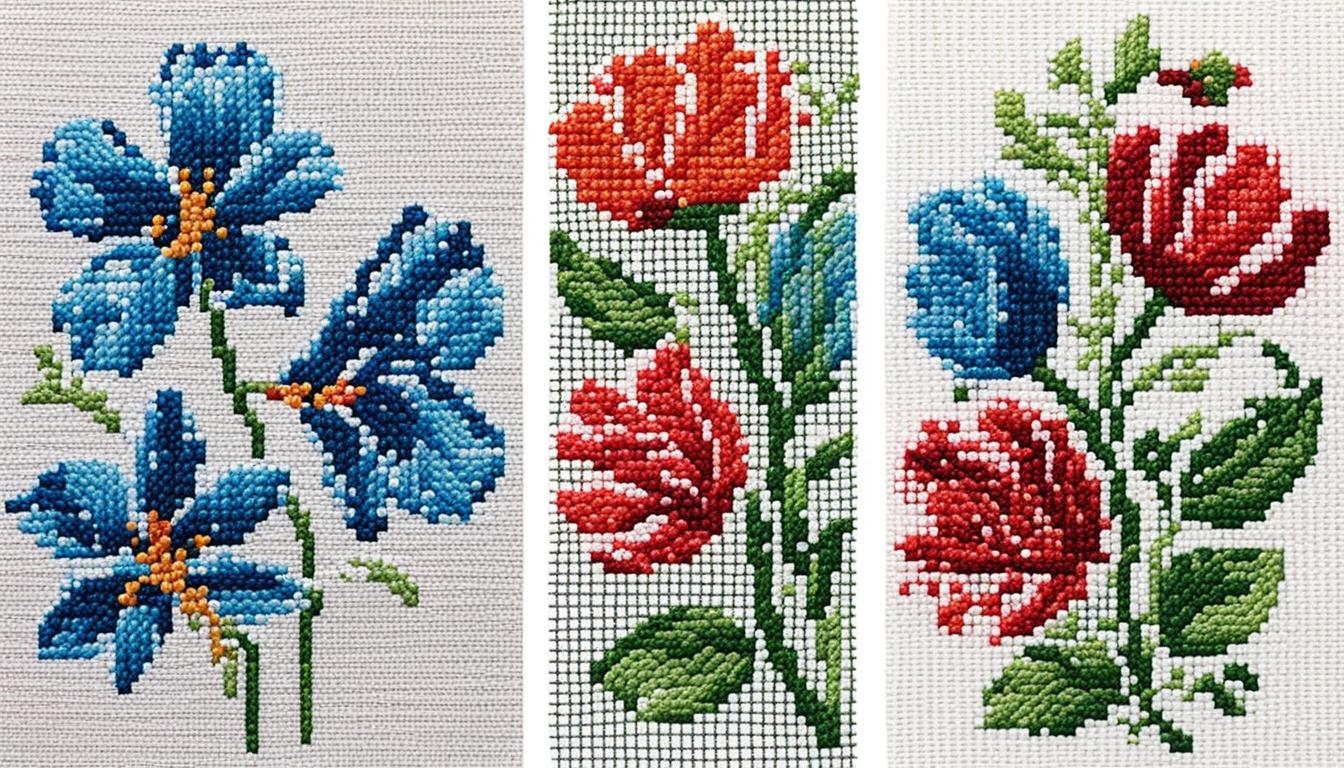In the world of cross stitch, what’s considered “wrong” can vary. You’ll find different opinions and many cross stitch techniques. Yet, some basic cross stitch tips and tricks can really help improve your work.
For neat, consistent results, it’s important to keep your stitches going in the same direction. Start with the lower stitch from the bottom left to the upper right. Then, place the top stitch from the lower right to the upper left. This way, your work will look uniform.
It’s also key to keep your thread from twisting. Not fixing this can make your stitches thin and your fabric look uneven.
When you’re just starting, focus on choosing the right fabric and thread counts. Make sure you use the correct number of strands to cover each fabric square well. Getting these basics right in your DIY projects will help you start strong.
Key Takeaways
- Consistency in top stitch direction leads to an even look in cross stitch projects.
- Twisting and ‘un-twisting’ threads can affect the appearance of your stitches.
- Selecting the right fabric (like Aida or linen) is essential for successful cross stitching.
- Using enough strands to cover fabric squares ensures adequate coverage.
- Practice and attention to detail are key to improving your cross stitch techniques over time.
Understanding the Basics of Cross Stitch
Starting with cross stitch means learning the basics first. This includes getting the hang of your first stitch and picking the right fabric. It’s considered one of the simplest embroidery types, even kids can learn it.
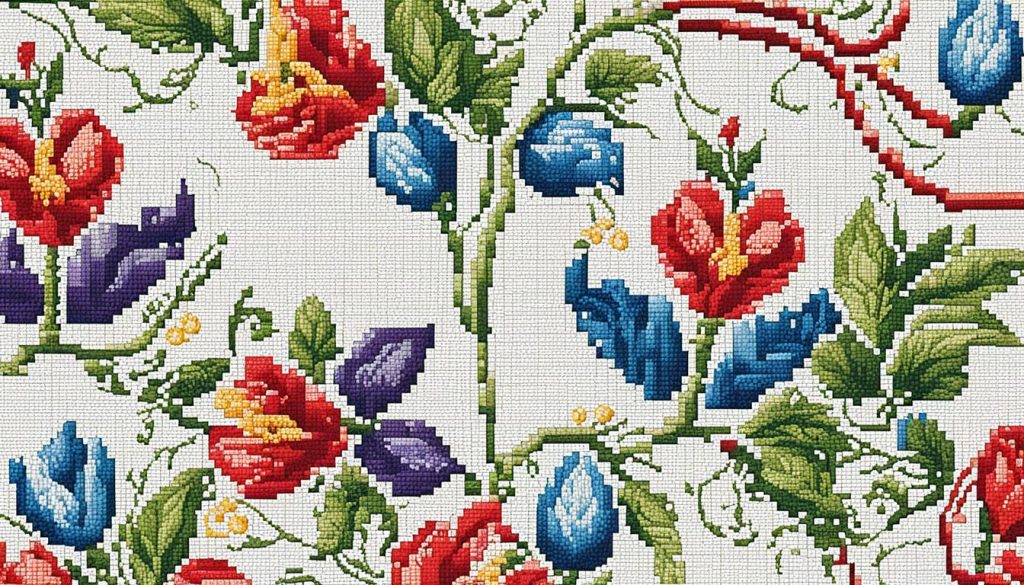
Your First Stitch
Starting with your first stitch is a big step. Most patterns use two strands of embroidery floss, which is six strands together. Each cross stitch is made of two half stitches (/ and \) to create the ‘x’ shape.
It’s smart to cut 18 inches of thread to avoid knots. Beginners should start stitching in the middle to keep the design balanced.
Tips for beginners include:
- Maintain proper tension on stitches.
- Avoid long jumps at the back of the fabric.
- Periodically let the needle and thread hang freely to unwind twists.
Choosing the Right Cross Stitch Fabric
Choosing the right fabric is key. Aida and linen are top choices because they have an even weave. This makes it easier to place stitches accurately. Aida is especially popular, with 14 count Aida cloth being a favorite.
Using hoops or frames keeps the fabric tight without stretching it out. To keep the fabric from fraying, you can tape or sew the edges. This makes working on your project neater.
Before you begin, make sure to:
- Mark the center of your fabric.
- Buy all your supplies at once to avoid color differences in the floss.
- Use blunt-ended needles for easy stitching.
Remember, cross stitch is both calming and fulfilling. Enjoy making your designs and focus on the process, not perfection.
Common Mistakes in Cross Stitch
Even experienced stitchers can make mistakes like twisted threads, uneven stitches, and wrong fabric tension. It’s important to know these errors and how to fix them. This way, you can make high-quality cross stitch embroidery pieces. We’ll look at some common problems and how to solve them.
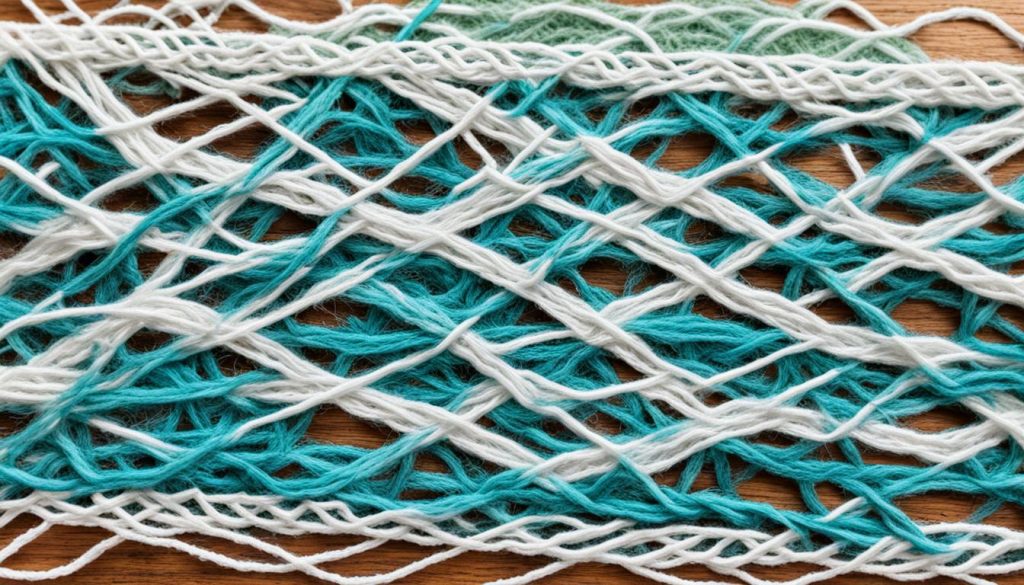
Twisted Threads
Twisted threads are a big issue for both new and skilled stitchers. They make your cross stitch embroidery look bad. To fix this, let your needle hang down to untwist the thread. This helps keep your stitches smooth and even.
Inconsistent Stitches
Stitches that are not the same can really mess up your work. If you change how you pull the thread or the direction of your stitches, your design won’t look right. Keep your thread tight and always stitch in the same way for even stitches.
Improper Fabric Tension
Getting the fabric tension right is key for a nice finish. If it’s too tight, your fabric will warp. If it’s too loose, it will pucker. Use a hoop or frame to keep your fabric even and smooth.
Here’s a table that shows common cross stitch mistakes and how to fix them:
| Mistake | Occurrence Rate | Solution |
|---|---|---|
| Thread Twisting | High | Let needle dangle to untwist regularly |
| Inconsistent Stitches | High | Maintain uniform stitch direction and tension |
| Improper Fabric Tension | Moderate | Use frame or hoop for even tension |
| Missed Stitches | Common | Fill in or use fabric pen to mark |
| Spilling on Project | Common | Wash carefully |
| Trailing Threads | Moderate | Weave under existing stitches |
| Knotting of Threads | Moderate | Use lower arm’s length thread |
By following these cross stitch tips and learning about cross stitch finishing techniques, you can make your projects better. You’ll avoid many common mistakes.
Cross Stitch Techniques for Beginners
Starting your cross-stitch journey can be both exciting and a bit scary. It’s key to learn some basic techniques to make it easier. You’ll need to know how to find the fabric’s center, handle colors and threads, and more.
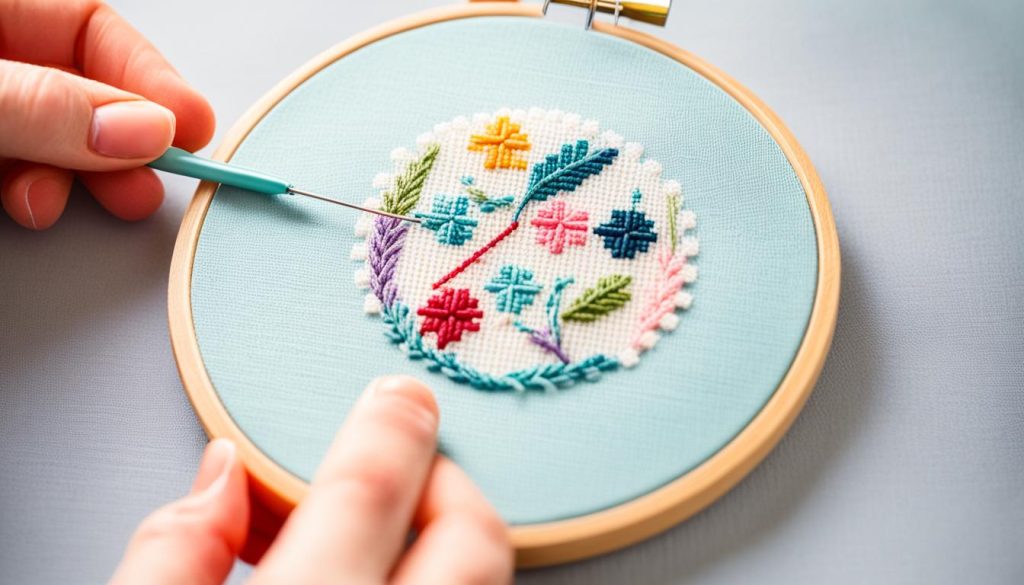
Starting in the Center
One top tip for beginners is to start stitching from the fabric’s center. This makes sure your design is symmetrical and you won’t run out of fabric. Charts often show the center with arrows on the edges.
To find the center, fold your fabric into quarters. Using kits with marked centers can also help a lot for newbies.
Working with Half Stitches
Half stitches are a great way to get started with cross-stitching. Start by making half stitches from right to left. This helps you set up your design and makes fixing mistakes easier.
Finish half stitches with cross stitches for a smooth flow. Watching tutorials can help you learn this technique better.
Managing Colors and Threads
Keeping your threads tidy is important for a nice-looking design. Choose quality threads like DMC and use techniques to keep them separate. Limit how far threads stretch across the fabric to avoid visible lines.
Trimming loose threads helps prevent tangles. Use charts and plan your colors ahead to make stitching easier.
Cross stitch kits come with everything you need, making them great for beginners. You can use different Aida fabric colors to make your design pop. Bamboo hoops are great for showing off your work. Online tutorials and communities offer more tips to help you improve.
Advanced Cross Stitch Designs
For those looking to elevate their skills, advanced cross stitch designs offer a wide canvas for creativity. These designs often include specialty stitches like Backstitch, Quarter Stitches, and Tent Stitch. They also feature Squat Stitches, French Knots, and Beads. These stitches add texture and challenge you to grow your skills.
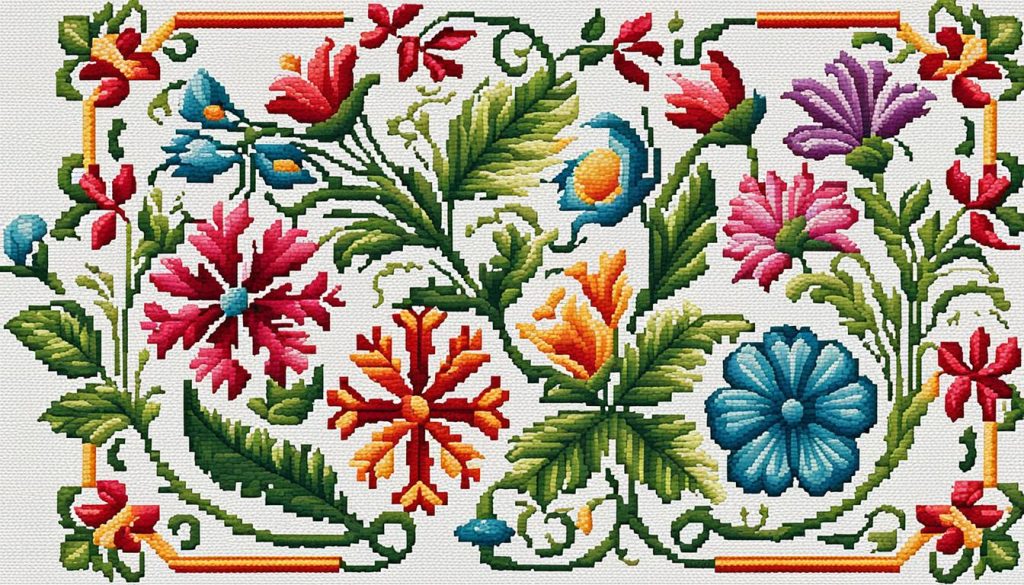
Exploring cross stitch history adds depth to this craft. It inspires you to mix traditional elements with modern patterns. This evolution shows how cross stitch art remains versatile and timeless.
Designers like Teresa Wentzler and Chatelaine are known for their use of specialty stitches. They often include stitches like Lazy Daisies and Smyrna Cross in their work. These stitches make their designs stand out in the world of cross stitch art.
| Kit Theme | Common Stitches | Average Price Range (£) |
|---|---|---|
| Cats | Smyrna Cross, Rhodes Stitch | 73.12 – 159.15 |
| Dogs | Backstitch, Quarter Stitches | 75.90 – 159.15 |
| Cityscapes | Tent Stitch, French Knots | 73.12 – 159.15 |
| Wildlife | Algerian Eyelet, Jessica Stitch | 73.12 – 159.15 |
| Traditional Designs | Diamond Eyelet, Squat Stitches | 73.12 – 159.15 |
Advanced kits cover a wide range of themes, from animals to cityscapes and wildlife. The Red India Elephant (v2) kit is the most expensive at £159.15. It shows the complexity and detail these kits offer. On the other hand, kits like Mandala Parade No2 and Moon Dance start at £73.12 and £75.90 respectively.
Today, there’s a vast selection of cross stitch designs for every enthusiast. Whether you prefer functional art or colorful patterns, advanced designs can enrich your skills. They also deepen your connection to cross stitch history.
Choosing the Right Cross Stitch Supplies
Using the right cross stitch supplies is key to success. The right tools make crafting smoother and more fun. We’ll explore different needles and threads to help you pick the best for your projects.
Types of Needles
Choosing the right cross stitch needles is crucial. Beginners should use tapestry needles because they don’t split the fabric. Gold-plated needles are also good because they don’t rust and won’t mark the fabric. Here are some sizes to consider:
- Size 24: Good for 14 count aida fabric
- Size 26: Ideal for 18 count fabric
- Size 28: Perfect for high counts and delicate fabrics
Types of Threads
The type of cross stitch threads you use affects your work’s look and feel. Brands like DMC, Anchor, and Sublime offer great quality. DMC threads are made from 100% Egyptian cotton, giving a shiny and silky look. Here are the main types of threads:
- Cotton Threads: Perfect for most projects, offering a smooth finish.
- Silk Threads: These give a luxurious sheen but are delicate.
- Metallic Threads: Add sparkle but need more patience.
- Variegated Threads: Create a multi-color effect, adding depth.
Knowing about each supply helps you improve your cross stitch projects. This ensures your work looks great and you’re happy with it. Here’s a table comparing fabric counts and threads:
| Brand | Fabric Count | Threads | Suitability |
|---|---|---|---|
| Zweigart | 14, 16, 18 counts | Aida fabric | Beginner to Intermediate |
| DMC | 14, 16, 18 counts | 100% Egyptian Cotton | All skill levels |
| Anchor | 14, 18, 20 counts | Cotton, Silk, Metallic | Intermediate to Advanced |
| Sublime | 14, 16 counts | Variegated Threads | Creative Projects |
Investing in quality cross stitch accessories and tools makes stitching easier and more fun. Choose well to get beautiful results.
Cross Stitch Patterns for Various Occasions
Finding the right design for special moments is exciting for crossstitching fans. Whether making gifts or decorating your home, there are patterns for every holiday and celebration.
Cross Stitch Christmas Patterns
Cross stitch Christmas patterns bring holiday cheer to life. They feature everything from Santa to winter scenes. These designs are great for decorating your home or as gifts for loved ones.
Cross Stitch Halloween Patterns
As autumn comes, crossstitching Halloween patterns are a fun way to celebrate. You’ll find designs with ghosts, witches, and pumpkins. They’re perfect for your home or as unique gifts.
Cross Stitch Wedding Patterns
Celebrate love with crossstitching wedding patterns that are romantic and elegant. They often include monograms and flowers, ideal for personalized gifts. These patterns turn simple gifts into treasured keepsakes.
| Occasion | Types of Designs | Uses |
|---|---|---|
| Christmas | Santa, Winter Landscapes | Home Decor, Gifts |
| Halloween | Ghosts, Witches, Pumpkins | Home Decor, Gifts |
| Wedding | Monograms, Floral Arrangements | Keepsakes, Gifts |
Conclusion
Cross stitch is more than just a hobby; it’s a way to express yourself creatively and connect with others. It welcomes everyone, from beginners to experts, offering joy at every step. Starting with simple stitches and picking the right fabric is key to your success.
As you get better, learning to control fabric tension and handle colors and threads is crucial. There are many resources available, like forums, communities, blogs, and YouTube channels, to help you improve. Many people find it helps with focus, reduces stress, and boosts fine motor skills.
You can make anything from holiday gifts to personal items for your home with cross-stitch. The craft is evolving, with more complex techniques and modern designs becoming popular. Dive into this craft and explore its endless possibilities. Being part of crossstitching communities and sharing your work can also be a great way to relax and connect with others.
